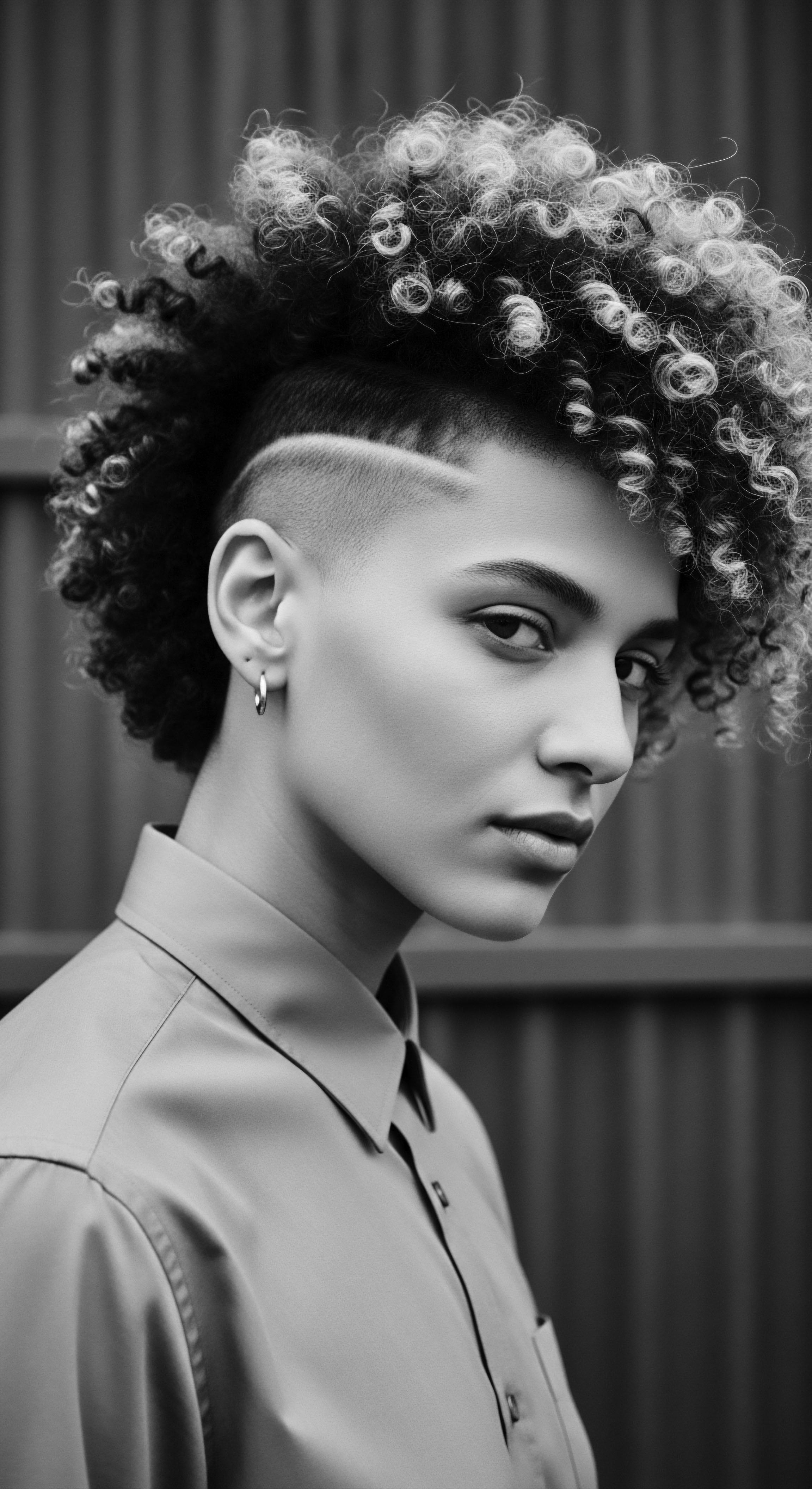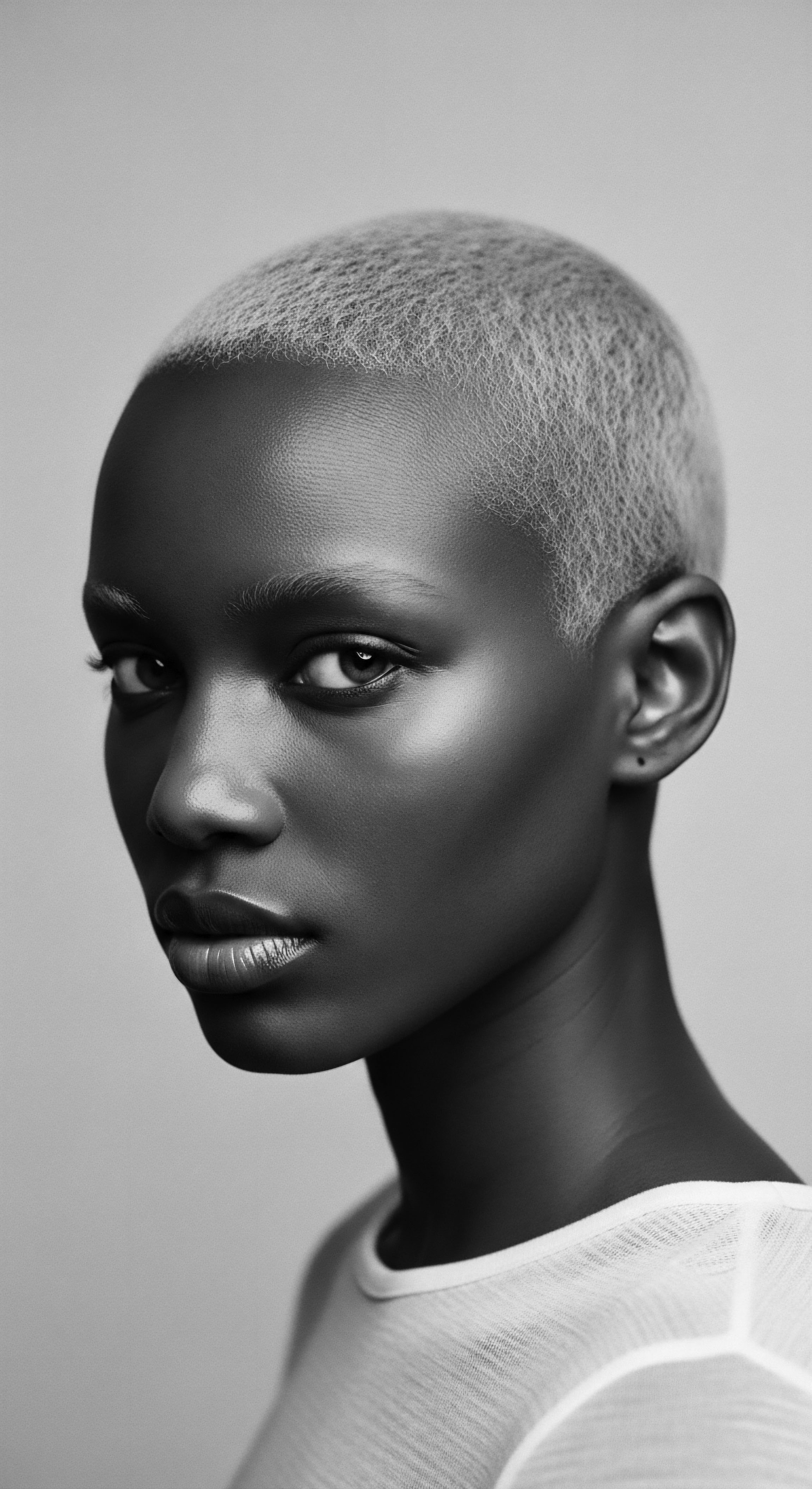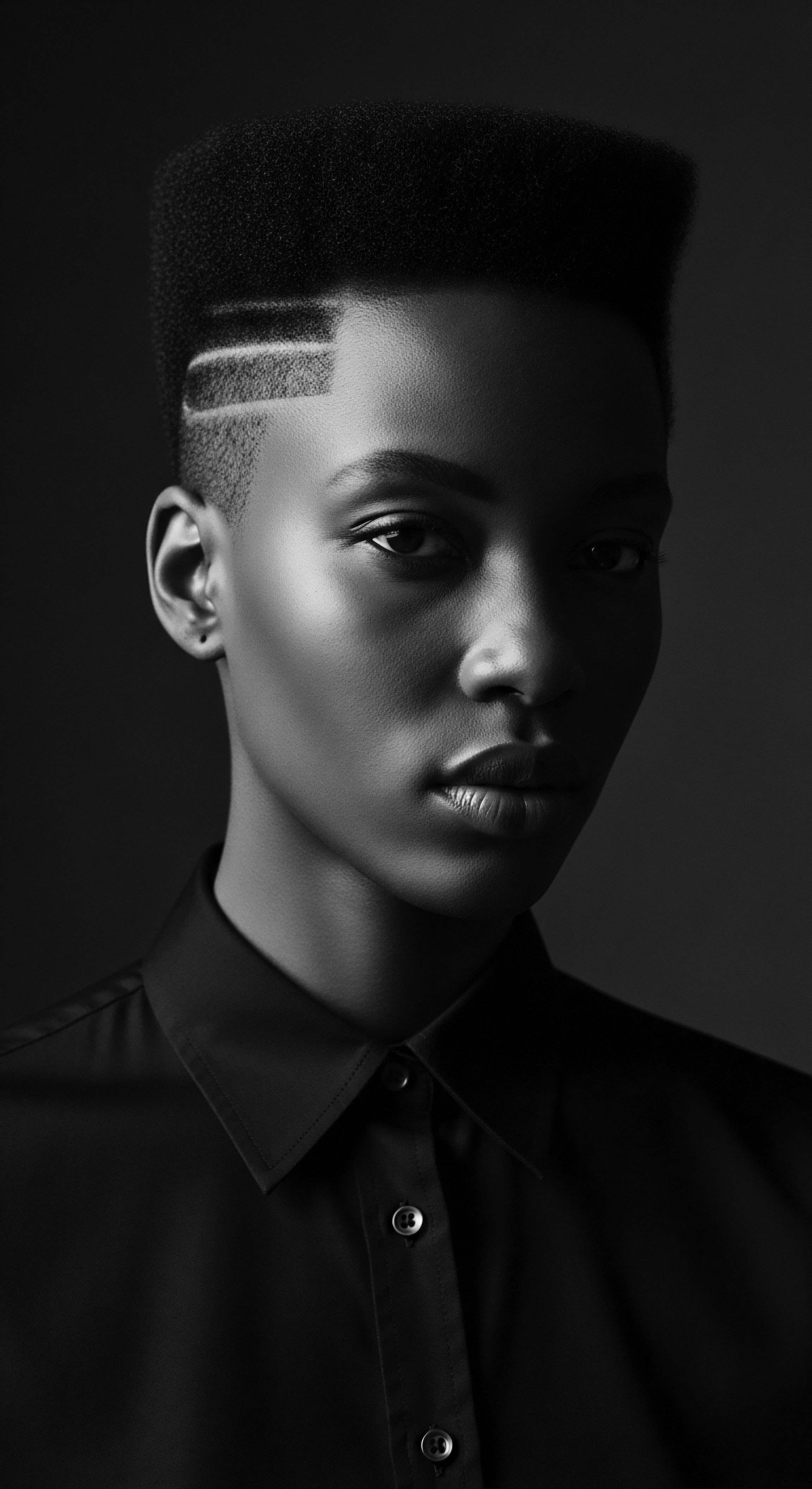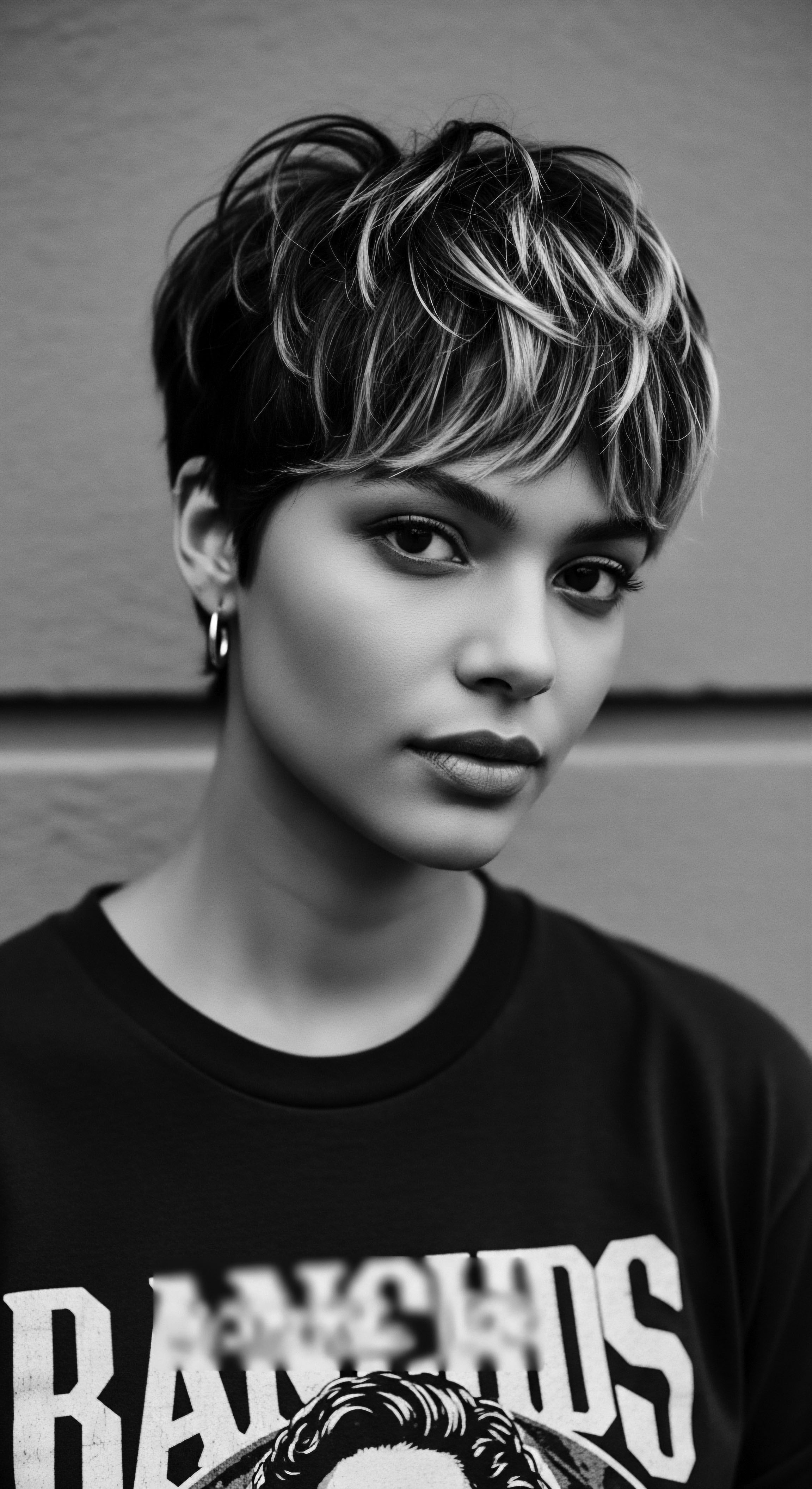
Roots
There is a knowing that lives within our strands, a whisper carried through generations, older than any textbook. It speaks of the earth’s bounty, the wisdom of hands that tended to coils and kinks long before laboratories could chart their secrets. For those of us with textured hair, this isn’t simply a biological trait; it is a living chronicle, a testament to resilience, a sacred connection to ancestral pathways. We carry histories in our coils, stories of survival, artistry, and self-possession.
Modern science, in its patient unlayering of molecular structures and cellular behaviors, now begins to affirm what our forebears understood intuitively, sometimes centuries ago. It charts the very mechanisms that lend credibility to practices held dear for eons, practices that were born of a deep, embodied relationship with hair, not merely as adornment, but as a vital extension of spirit and identity.

The Architecture of Ancestral Strands
The science of hair texture starts at the follicle. Unlike straight hair, which springs from a round follicle, textured hair emerges from an elliptical or oval-shaped follicle. This asymmetry causes the hair shaft to grow in a curved or helical pattern as it exits the scalp. The degree of ovalness in the follicle often determines the tightness of the curl, from broad waves to tightly wound coils.
This curvature influences everything from how natural oils distribute down the strand to how moisture is absorbed and retained. Our ancestors, lacking microscopes, may not have articulated “follicle shape” or “disulfide bonds,” yet their care practices implicitly accounted for these very realities. They recognized the unique needs of hair that naturally resisted straight descent, hair that sought to coil and spring.
Moreover, the angle at which the follicle sits within the scalp also plays a role in the curl pattern. Hair that grows at a more acute angle to the scalp tends to exhibit greater curvature. This biological blueprint means that textured hair, by its very nature, possesses points of natural bending and twisting along its length. These points, while contributing to the remarkable volume and sculptural quality of textured hair, also present areas of potential fragility.
It is here that ancient wisdom steps in, offering insights into how to honor and protect these delicate formations. They understood that these seemingly delicate bends were actually sources of strength when properly nourished and shielded. (Medical News Today, 2017)

What Does Textured Hair’s Natural Porosity Mean for Care?
Another scientific insight confirming ancient wisdom relates to hair porosity. Hair porosity describes how well the outermost layer of the hair, the cuticle, absorbs and retains moisture. The cuticle is comprised of overlapping, scale-like cells.
In textured hair, particularly tighter curl patterns, the cuticle often sits in a more raised or open position, allowing for easier moisture absorption, yet also quicker moisture loss. This characteristic leads textured hair to be naturally drier, as the scalp’s natural oils, known as sebum, struggle to travel down the twists and turns of the coiling strands.
Ancient care practices implicitly recognized the unique moisture needs of coiled hair, even without modern scientific terms.
Ancestral practices, from the systematic use of oils and butters to protective styling, directly addressed this reality. They applied rich emollients and sought to seal in moisture, recognizing the hair’s tendency toward dryness. These traditions intuitively understood the hair’s relationship with its environment, developing rituals that counteracted natural moisture evaporation. This understanding was not gleaned from scientific papers, but from generations of lived experience and keen observation, a heritage of empirical knowledge passed down through the ages.
| Follicle Shape Round |
| Hair Type Produced Straight Hair |
| Traditional Understanding or Practice Often seen in cultures where hair hung freely; emphasized smoothness. |
| Follicle Shape Oval to Elliptical |
| Hair Type Produced Wavy to Coily Hair |
| Traditional Understanding or Practice Required methods to manage dryness, preserve patterns; celebrated volume. |
| Follicle Shape The shape of the hair follicle determines curl, a biological truth underpinning centuries of diverse hair care. |

Ritual
For countless generations, the care of textured hair transcended mere personal hygiene; it embodied a profound cultural practice, a communal act, a spiritual connection. The whispers of old, carried on the breeze and through the gentle hands of elders, spoke of hair as a conduit for wisdom, a living memory of lineage. Science, in its quiet, methodical way, has begun to validate the practical efficacy of these deeply rooted rituals, revealing how ancestral practices aligned with hair’s biological needs, even when the underlying mechanisms remained unspoken. These are not coincidences; they are echoes of an ancient, empirical science.

What Was the Ancestral Purpose of Protective Styles?
Consider the expansive legacy of Protective Styles—braids, twists, Bantu knots, and locs. These styles, which are prominent in African and African Diasporic cultures, are far older than any contemporary trend, with origins dating back thousands of years. (Flora & Curl, 2022) Scientifically, these styles shield the hair shaft from environmental stressors like wind, sun, and friction, all of which contribute to mechanical damage and moisture loss. By gathering and securing the hair, protective styles minimize daily manipulation, which is a significant factor in breakage for textured hair, given its natural fragility at points of curvature.
Historically, braids communicated more than protection; they were visual markers of tribal affiliation, social status, age, and marital standing. During periods of enslavement, these styles took on a particularly powerful, covert function. Enslaved African women famously braided rice seeds into their hair as a means of preserving sustenance and cultural memory during forced migration.
Some also used complex braid patterns as maps for escape routes, a poignant example of hair as a tool for survival and silent defiance. (BLAM UK CIC, 2022)
The time-consuming nature of these practices also solidified their communal importance. Hair styling sessions were often intergenerational gatherings, where knowledge was transmitted, stories were shared, and familial bonds were strengthened. The hands-on practice, repetitive and mindful, became a ritual of connection, an affirmation of collective heritage. This aspect of communal care, though not a direct scientific insight, certainly created an environment conducive to consistent hair maintenance, which contributes to overall hair health.

How Do Ancient Oils and Butters Nurture Textured Hair?
The generous application of natural oils and butters stands as another testament to ancestral wisdom. For generations, materials like Shea Butter and Castor Oil were staples in African hair care. (Africa Imports, 2023) Modern scientific analysis now reveals why. Shea butter, extracted from the nuts of the African shea tree, is rich in fatty acids and vitamins A and E, making it an excellent emollient and humectant.
It forms a protective barrier on the hair shaft, sealing in moisture and shielding it from environmental aggressors. Castor oil, sourced from the seeds of the Ricinus communis plant, is notable for its high concentration of ricinoleic acid, which contributes to its moisturizing properties and ability to penetrate the hair shaft. (African Pride, n.d.) It has also been observed to stimulate circulation when massaged into the scalp, aiding hair growth. (African Pride, n.d.)
These oils and butters addressed the inherent dryness of textured hair, a condition that modern science attributes to the unique shape of the hair follicle hindering sebum distribution. (Natural Hair Berlin, n.d.) Ancient practitioners, observing the hair’s response to these emollients, understood their restorative and protective qualities. The rhythmic act of anointing the scalp and strands with these natural gifts was more than physical care; it was a blessing, a moment of connection to the earth’s giving spirit, a validation of the hair’s sacred place. (Substack, 2025)
The systematic use of oils and protective styling in ancient traditions directly counters textured hair’s natural tendency toward dryness and breakage.
The practice of Hair Oiling, often a pre-wash ritual, also finds scientific backing. Studies indicate that oils like coconut oil can reduce protein loss in hair, particularly when applied before washing. (ResearchGate, 2024) Coconut oil, with its primary component lauric acid, possesses a molecular structure that allows it to penetrate the hair shaft, rather than merely sitting on the surface.
This deep penetration helps to strengthen the hair from within, guarding against breakage during cleansing. (African Pride, n.d.)
- Coconut Oil ❉ Its unique molecular structure, particularly lauric acid, allows it to penetrate the hair shaft, preventing protein loss during washing and hydrating deeply.
- Castor Oil ❉ Rich in ricinoleic acid, it moisturizes and creates a protective shield, with observations suggesting improved scalp circulation for hair growth.
- Shea Butter ❉ A fatty acid and vitamin rich emollient, it seals in moisture and acts as a barrier against environmental elements.
- Rhassoul Clay ❉ This mineral-rich clay from Morocco offers moisturizing and remineralizing properties for both hair and scalp, aiding in detangling and reducing frizz.
| Traditional Ingredient Coconut Oil |
| Ancestral Application Pre-wash treatment, moisturizer |
| Confirmed Scientific Property Penetrates hair shaft, reduces protein loss, antibacterial. |
| Traditional Ingredient Shea Butter |
| Ancestral Application Moisturizer, protective balm |
| Confirmed Scientific Property Emollient, rich in vitamins A & E, seals moisture. |
| Traditional Ingredient Castor Oil |
| Ancestral Application Scalp massage, strengthening agent |
| Confirmed Scientific Property Ricinoleic acid for moisturizing, improved circulation. |
| Traditional Ingredient Rice Water |
| Ancestral Application Rinse for strength, shine |
| Confirmed Scientific Property Contains inositol and amino acids for repair and resilience. |
| Traditional Ingredient Rhassoul Clay |
| Ancestral Application Cleanser, mask |
| Confirmed Scientific Property Remineralizing, moisturizing, clears scalp pores. |
| Traditional Ingredient Ancient ingredients, though used without scientific labels, demonstrate clear biological benefits for hair health. |

Relay
The stories etched into textured hair extend beyond biological structures and practical rituals; they resonate as a vibrant cultural inheritance, a living archive of identity and self-assertion. The deep human connection to hair as a marker of belonging, resistance, and legacy is increasingly illuminated by cross-disciplinary studies, bridging anthropology, history, and the very biology of our strands. This is where scientific understanding helps us appreciate the profound ingenuity embedded within our shared heritage.

How Do Nighttime Rituals Protect Hair?
The practice of safeguarding hair during sleep, especially with accessories like bonnets or headwraps, is a tradition with deep roots in Black communities. These coverings, often made of silk or satin, mitigate friction between hair strands and coarser bedding materials like cotton. (Byrdie, 2022) Scientifically, this friction can cause breakage, frizz, and moisture loss, especially for delicate textured hair. The smooth surface of silk or satin allows hair to glide, significantly reducing mechanical stress.
(Byrdie, 2022) Moreover, these coverings help to maintain the hair’s moisture balance by creating a micro-environment that slows evaporation, preserving the hydration meticulously applied during a daytime regimen. This preventative measure is particularly significant for textured hair, which, as discussed, is prone to dryness due to its unique structure. (Cabela, 2025)
The use of head coverings carries an multifaceted history within African American culture. While they served the practical purpose of hair protection, particularly during the harsh conditions of enslavement, they also acquired symbolic weight. Headwraps could obscure hair texture that was often denigrated under Eurocentric beauty standards, offering a form of dignity and subtle resistance. Some historians speculate that the folds of headscarves even held coded messages, a form of silent communication among enslaved women.
(Byrdie, 2022) These items evolved from simple necessity into powerful symbols of resilience, identity, and the enduring cultural memory of a people determined to preserve their essence. (Hype Hair, 2023)

What Role Does Community Play in Textured Hair Heritage?
The collective nature of hair care, particularly within Black and mixed-race communities, holds significant cultural weight. Historically, hair styling was not an isolated act; it was a communal event, fostering intergenerational bonds and transmitting knowledge. Grandmothers, aunts, and mothers passed down techniques for braiding, twisting, and caring for hair, along with the wisdom of herbal remedies and protective practices. This communal aspect ensured the continuity of these practices, providing hands-on education and a shared understanding of hair’s needs.
The very act of gathering to “do hair” became a powerful reinforcement of family and community ties. (Afriklens, 2024)
The communal act of hair styling, a bedrock of textured hair heritage, serves as a powerful means of transmitting knowledge and solidifying cultural bonds.
Beyond the practical skills transferred, these shared moments cemented the hair’s cultural significance. Discussions about hair type, preferred products, and historical styles became part of a living oral tradition, strengthening collective identity. This shared experience creates a sense of belonging and cultural pride, standing against historical attempts to diminish the beauty and complexity of textured hair. The reclamation of natural hair styles in modern times often taps into this ancestral wellspring of communal support and shared heritage.

Are Ancient Hair Rinses Scientifically Validated?
Ancient civilizations across various continents utilized hair rinses derived from plants and other natural ingredients. Consider the widespread use of Rice Water in Asian cultures, particularly by the Red Yao women of China, famed for their long, strong hair. (Substack, 2023) Scientific investigation now attributes the benefits of rice water to its rich composition of inositol, a carbohydrate known for its ability to repair damaged hair, and amino acids, the building blocks of protein.
(Substack, 2023) These components can strengthen the hair shaft, reduce friction, and improve elasticity, leading to less breakage and enhanced shine. (Substack, 2023)
Similarly, herbal rinses using ingredients like rosemary, nettle, or chamomile, common in ancient European and African traditions, are gaining modern scientific interest. Rosemary, for instance, has been shown to potentially stimulate hair growth and address scalp conditions. (The Afro Curly Hair Coach, 2023) Nettle can help with hair loss, and chamomile can soothe an irritated scalp and add a natural brightening effect to lighter hair.
(The Afro Curly Hair Coach, 2023) These plant-based rinses provide a gentle approach to scalp health and hair strength, often imparting beneficial compounds without the harshness of some modern chemical formulations. Their long-standing presence in ancestral care practices highlights an intuitive understanding of botanical properties that contemporary science is now decoding.
- Fermented Rice Water ❉ Contains inositol, which remains in the hair even after rinsing, shielding strands from damage and enhancing elasticity. (Substack, 2023)
- Herbal Teas ❉ Brews from plants like hibiscus or rooibos tea offer antioxidants and antimicrobial properties that can improve scalp health and hair strength.
- Yucca Root ❉ Used by Native American tribes, it contains saponins that create a natural lather, gently cleansing hair without stripping its natural oils. (22 Ayur, n.d.)

Reflection
To stand at this juncture, where the careful hand of ancestral practice meets the probing gaze of scientific inquiry, is to behold a magnificent convergence. The wisdom passed through whispered stories and practiced hands, often deemed “folk” knowledge, now receives validation from the very instruments and methodologies of contemporary research. It reveals that the heart of textured hair care, its resilience, its unique demands, was understood long before molecular diagrams and chemical compounds could name the “why.” This journey through follicles, botanicals, and communal rites affirms that textured hair is far more than a collection of proteins; it is a profound testament to memory, identity, and continuity.
Each coil, each kink, each wave carries the collective spirit of those who came before, a living, breathing archive of heritage. Roothea’s ‘Soul of a Strand’ ethos finds its deepest affirmation here ❉ that in honoring our hair, in understanding its ancient story through the lens of modern knowledge, we not only nurture our physical selves but also fortify the luminous legacy of our lineage, ensuring its vibrant continuation.

References
- Barnes, A. (2023, August 16). Strands of Inspiration ❉ Exploring Black Identities through Hair. Smithsonian National Museum of African American History and Culture.
- BLAM UK CIC. (2022, September 15). The history of Black Hair.
- Byrdie. (2022, September 27). The Significance and History of Bonnets.
- Cabela. (2025, April 2). CURLY BY DESIGN ❉ How your hair follicles shape your curls.
- Cooper Delivered. (n.d.). Botanical Ritual Library.
- Flora & Curl. (n.d.). The History of Black Hairstyles.
- Hype Hair. (2023, June 26). Unveiling the History of the Hair Bonnet for Black Women.
- Medical News Today. (2017, July 21). Curly or straight ❉ What determines hair shape?
- Natural Hair Berlin. (n.d.). Curly Hair Science ❉ Understanding Hair Structure, Follicles & Porosity.
- ResearchGate. (2024, June 28). Hair oiling ❉ a paradigm shift in the deep-rooted ritual from East to West.
- ResearchGate. (n.d.). Herbal hair oil ❉ A review.
- Salford Students’ Union. (2024, October 29). The Remarkable History Behind Black Hairstyles.
- Substack. (2025, May 4). Ancestral Hair Rituals to Nourish Your Hair and Soul.
- Substack. (2023, November 28). Ancestral Wisdom Meets Modern Formulation in Rice Water Shampoo.
- The Afro Curly Hair Coach. (2023, March 4). CHECK OUT THESE TRADITIONAL HAIRCARE TREATMENTS.
- The Chief of Style. (n.d.). Beauty Beyond Borders ❉ 7 Ancient Rituals for Modern Self-Love.
- 22 Ayur. (n.d.). The Ancient Natural Ways of Hair Care Across Continents.
- Afriklens. (2024, November 1). African Hairstyles ❉ Cultural Significance and Legacy.
- African Pride. (n.d.). Natural Hair Care 101 ❉ Choosing The Right Oil For Your Hair Type.
- Africa Imports. (n.d.). Traditional African Secrets For Long And Healthy Hair.
